
This 1-Ingredient Gluten-Free Buckwheat Bread recipe is an absolute game-changer! I’ve been making it every single week since early 2022, and it never disappoints! It’s incredibly easy, delicious, and super nourishing. I highly recommend throwing a couple of slices in the toaster/oven to create the ultimate avocado toast or as a side dish for dipping into soup. It even makes amazing croutons in a salad!
Since sharing this recipe with our community on social media, it’s become one of our most popular recipes to date. Hundreds of our community members have shared their versions with us on Instagram. Check out our Buckwheat Bread Instagram Highlights to see just a sample of the ones we’ve received, and please make sure to share your own! If you’re in interested in more gluten-free bread recipes, you’ll also love this super fluffy Red Lentil Quinoa Bread!

Ingredient Notes
- Hulled Raw Buckwheat: Buckwheat groats (or kernels) are the hulled seeds of the buckwheat plant. Despite their name containing the word “wheat,” buckwheat is actually gluten-free and makes for a fantastic bread ingredient. These groats are a staple in many Eastern European and Asian cuisines, known for their nutty flavor and versatile use. This Healthy Buckwheat Bread Recipe is a testament to that.
- Water: Tap water is fine to use depending on your location, if the water is heavily chlorinated in your area, you should choose filtered water, as chlorine will impact the fermentation.
- Salt: Either sea salt flakes or table salt works fine. The salt enhances the natural flavor of the buckwheat.
- Poppy and Sesame Seeds: Adds a delightful crunch and visual appeal to the bread. They are optional but highly recommended for an extra touch of flavor and texture. You can top it with any seeds you like.
IMPORTANT: Use ONLY hulled, non-roasted buckwheat for this recipe. Buckwheat flour, unhulled buckwheat, activated buckwheat, or roasted buckwheat will not work in this recipe.
Why You’ll Love This 1-Ingredient Buckwheat Bread Recipe
- Delicious and Dense: It’s absolutely delicious, with a dense, satisfying texture, and gets even better when toasted! Fermentation not only enhances the flavor, but it can improve the bioavailability of certain nutrients in foods. Specifically, the fermentation process can reduce levels of phytic acid, which is known to bind some minerals and reduce their absorption. By breaking down phytic acid, fermentation can make minerals like iron, zinc, and magnesium more available for absorption by the body.
- So Easy: Although the fermentation process takes a bit of time, this recipe is very hands-off and only requires about 10 minutes of actual work. If you use the right kind of buckwheat, a high-speed blender, and follow the instructions, this simple, yeast-free bread recipe is practically foolproof.
- Cost-effective: Good quality, nourishing, gluten-free bread can be quite expensive where we live, often costing around $15 AUD (~ $9.80 USD), whereas this Gluten-Free Buckwheat Bread comes in at under $3.50 AUD (~ $2.30 USD), even when using organic hulled buckwheat.
- Meal-Prep: Easy to prep in advance and can be frozen. I usually keep half fresh, wrapped in a clean kitchen cloth, to consume in the next few days and slice and freeze the rest. Toast when ready to eat, and it’s as good as fresh! This way, you can toast a piece whenever you crave some delicious bread.
What Are the Health Benefits of Buckwheat?
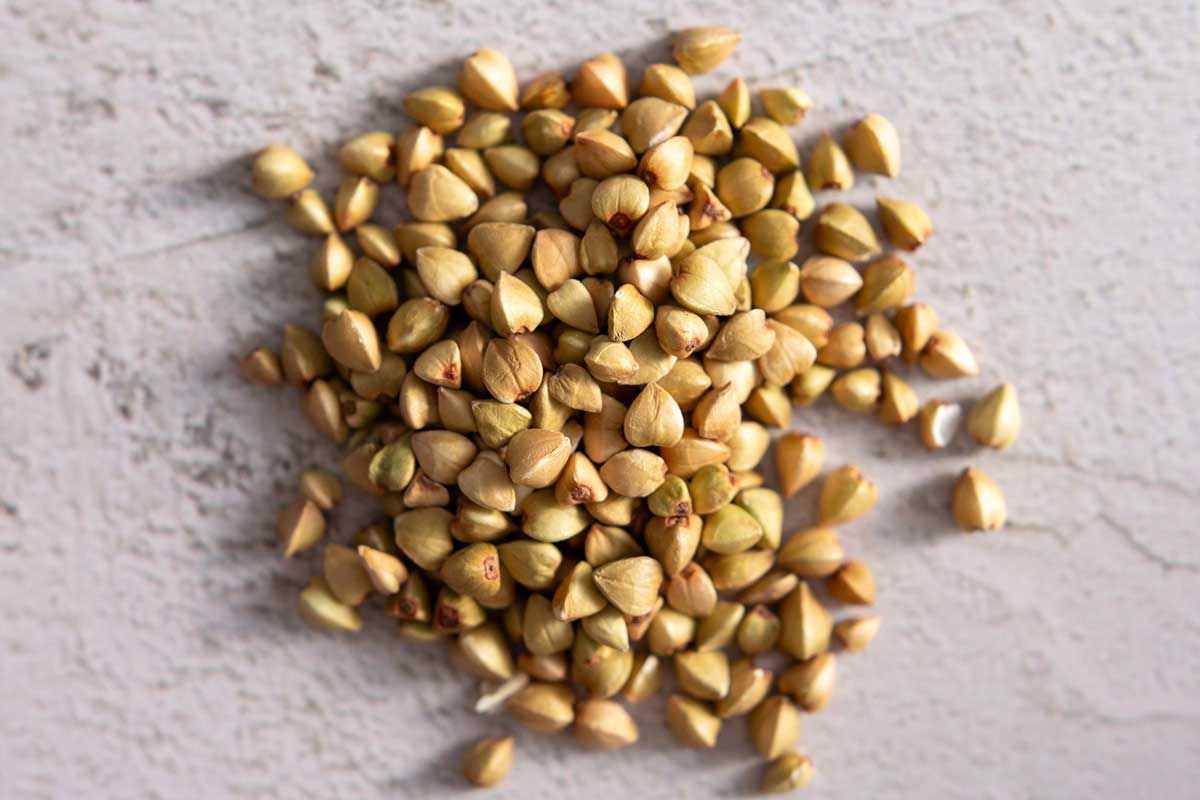
- Buckwheat is highly nutritious, offering a source of fiber and essential minerals, especially magnesium. It’s also packed with antioxidants, particularly rutin, which supports blood vessel health. Despite its name, buckwheat is naturally gluten-free, making it suitable for those with gluten intolerance or celiac disease.
- Buckwheat’s low to medium glycemic index makes it a good choice for those managing blood sugar levels. Plus, its high fiber content aids in digestion.
- Like amaranth or quinoa, these whole grain groats can be cooked like rice or oats, making them a fantastic ingredient for various dishes. From traditional porridge and pilafs to modern salads and even as a rice substitute, buckwheat is incredibly adaptable. It’s also used in making buckwheat flour, a popular alternative for gluten-free baking. We use buckwheat flour to make these High-Protein Buckwheat Pancakes with Blueberry Syrup, and they’re so fluffy and delicious!
Step-by-Step Instructions
Rinse the hulled buckwheat kernels under cold water until clear. After rinsing, soak 17.5 oz (2.6 cups or 500g) of buckwheat in cold water in a large bowl, fully submerged, and cover with a clean cloth for 6 to 7 hours.
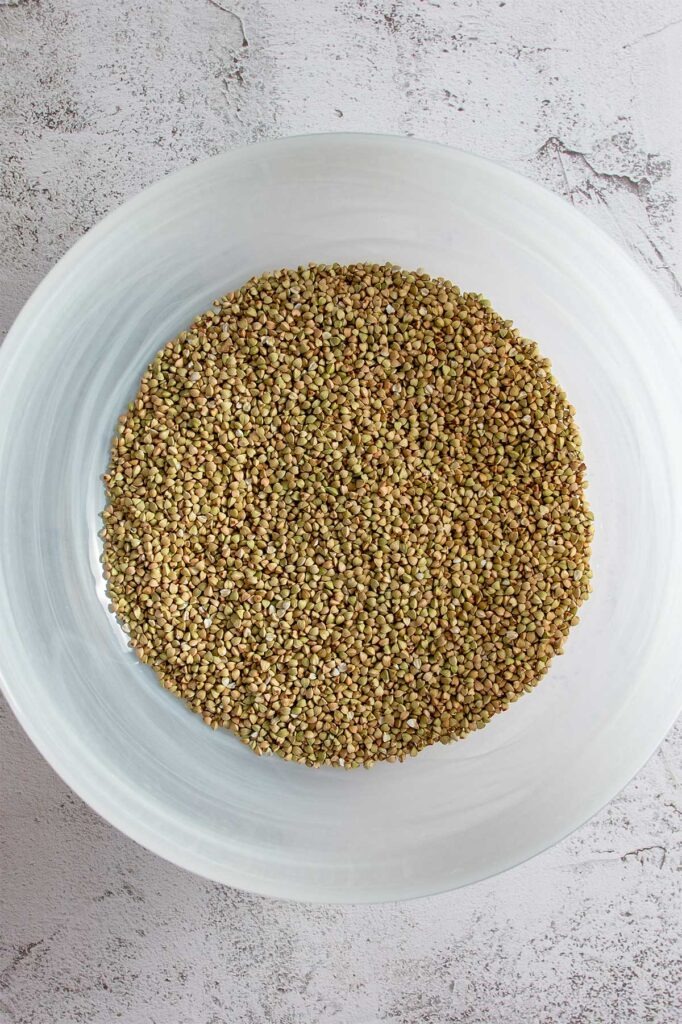

Once soaked, drain the remaining water, but do not rinse.


Transfer to a blender with 6.8 fl oz (0.9 cups or 200 ml) of water and ¼ tsp salt. Blend, starting at low speed and slowly increasing, until you get a very smooth texture without any pieces left. Pour the blended buckwheat mixture back into the bowl.
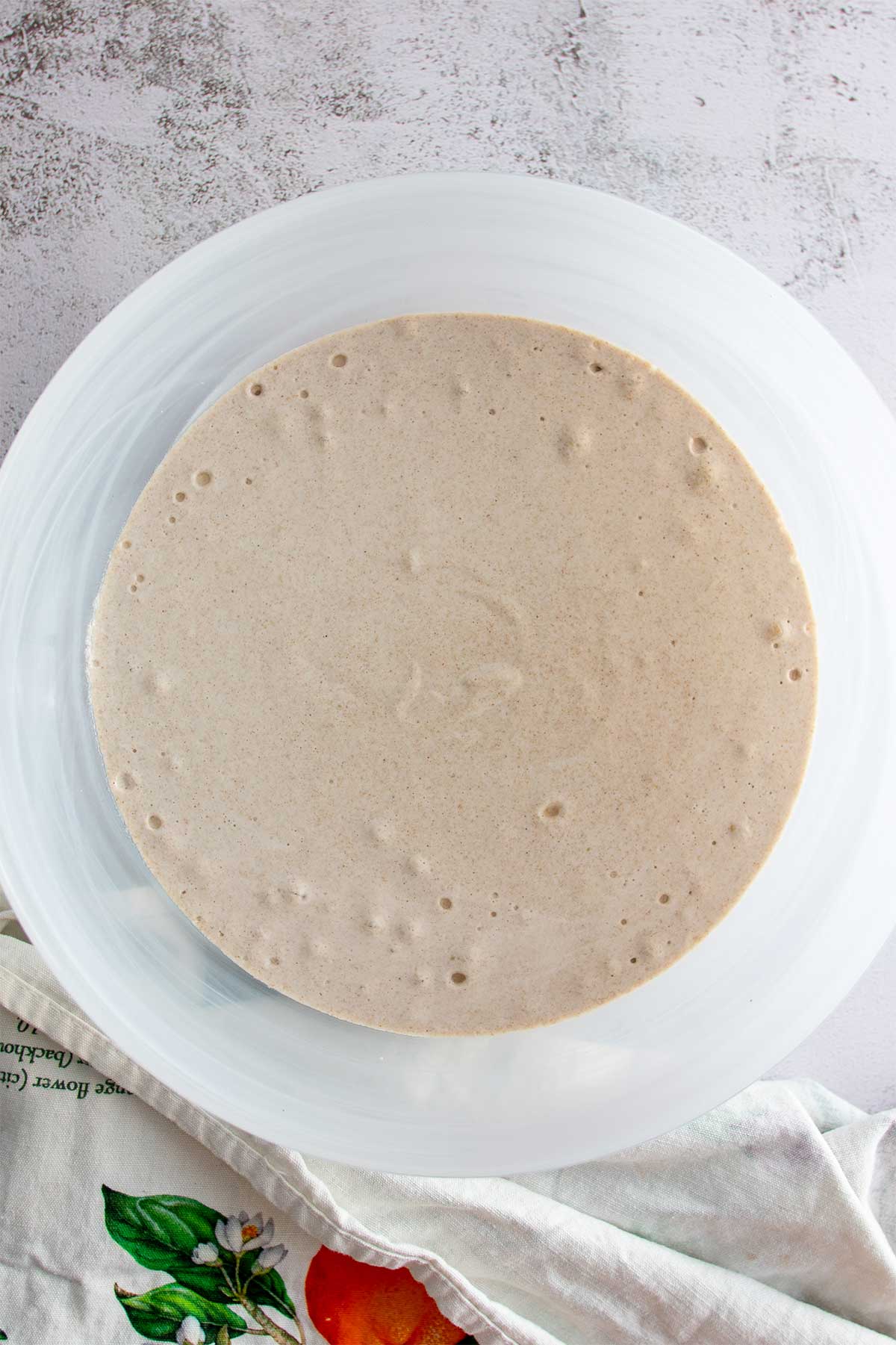
Cover it again and let it sit at room temperature for 12 to 24 hours to ferment. Please check the fermentation table below to confirm the time required based on your current climate.
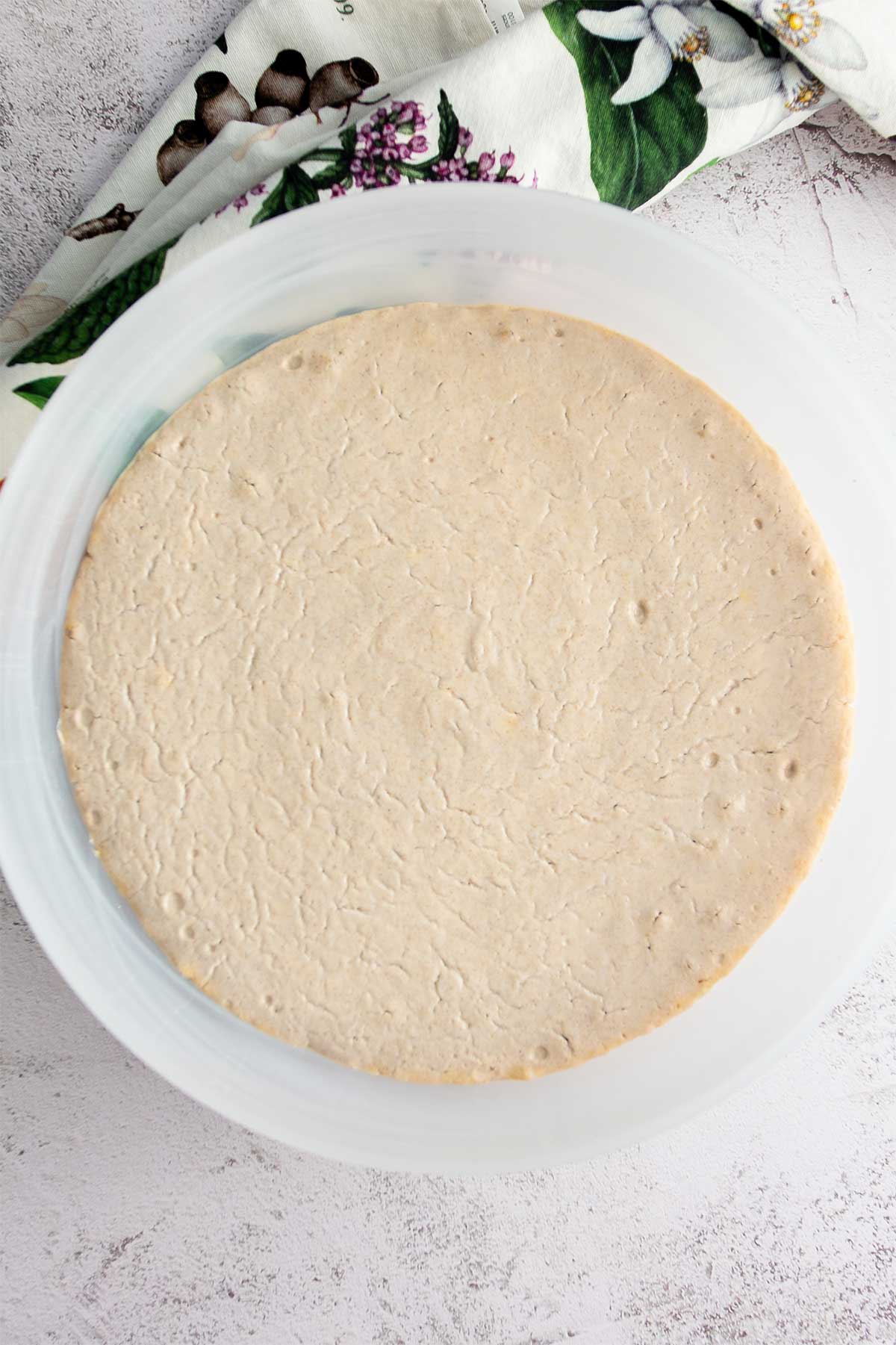

When you’re ready to bake, preheat your oven to 350°F. Line a loaf pan with baking paper and pour the fermented buckwheat dough into the pan. If you’d like, sprinkle the top with 2 tsp of poppy and sesame seeds (or whichever toppings you’d like).


Bake the bread in the preheated oven for 90 minutes. The bread should be golden brown and firm to the touch.


Allow the bread to cool down before slicing. This makes it easier to cut and improves the texture. Enjoy your homemade, nourishing, gluten-free buckwheat bread!


How Long to Ferment Your Buckwheat Bread Based on Your Current Climate
🌨️ Colder (Winter)
Indoor temperature range: ~70°F (20°C)
Soak: 6–7 hours
Fermentation time: Up to 24 hours
Note: If the temperature is lower than 70°F (20°C), place the bread in a warm spot or near a gentle heat source to help it ferment.
☀️ Warm (Summer)
Indoor temperature range: 75–85°F (25–30°C)
Soak: 6–7 hours
Fermentation time: Around 12 hours
Note: A warm environment speeds up fermentation, so check the texture after 10–12 hours.
🔥 Very Hot
Indoor temperature range: Above 85°F (30°C)
Soak: 6 hours
Fermentation time: As little as 6 hours
Note: The hotter it is, the less time needed. In extreme heat, soak the buckwheat in the fridge for 6 hours only.

1-Ingredient Buckwheat Bread (Nourishing and GF)
Equipment
Ingredients
- 17.6 oz (500 g) hulled buckwheat kernels (2.6 cups) - MUST be hulled, raw buckwheat kernels/groats for this recipe to work
- 6.8 fl oz (200 ml) water (0.9 cups)
- ¼ tsp (1.5 g) sea salt flakes
- 2 tsp (4 g) poppy and sesame seeds - optional
Instructions
- Rinse the hulled raw buckwheat kernels under cold water until the water runs clear. This ensures that any dust or impurities are removed.
- Transfer the rinsed buckwheat to a large bowl. Cover the kernels with a large volume of cold water, ensuring they are fully submerged. Cover the bowl with a clean cloth and let it sit for 6 to 7 hours.
- Once soaked, drain the water, but do not rinse the buckwheat kernels. Transfer them to a blender with 6.8 fl oz (0.9 cups/200 ml) water and the salt. Blend, starting at low speed and slowly increasing until you get a very smooth texture without any bits and pieces of buckwheat remaining.
- Pour the blended buckwheat batter back into the bowl. Cover it again and let it sit at room temperature for 12 to 24 hours (please see notes to determine how long you should leave it to ferment based on your climate). Once fermented, you will notice a very slight rise, and the mixture should be slightly bubbly inside.
- When you're ready to bake, preheat your oven to 350 °F. While the oven is heating, prepare a loaf pan by lining it with baking paper.
- Pour the fermented buckwheat dough into the prepared loaf pan. If using, sprinkle the top with poppy and sesame seeds.
- Bake the bread in the preheated oven for 90 minutes.
- Remove the bread from the loaf pan and let it cool completely before slicing. This is important to get the best texture. Now, enjoy your homemade, healthy buckwheat bread!
Video
FAQ
This depends on your location and current temperature, as fermentation is temperature-dependent. Colder climates will need a longer fermentation, and it can be shortened as the temperatures rise during the year, as the heat accelerates fermentation.
For colder climates (winter, with an indoor temperature of approximately 70°F (20°C)), ferment for 24 hours. If your indoor temperature is below 70°F (20°C), you can try leaving the batter in the warmest place in your house to give it the best chance of fermenting.
For warmer climates (summer with an indoor temperature between 75 – 85°F (25 – 30°C), I’d recommend starting with 12 hours of fermentation. We have tested this recipe in both summer and winter in Sydney Australia, which remains a pretty temperate climate. Depending on where you are in the world there might be a little bit of experimenting to figure out the perfect timing, but I promise it’s well worth it!
Some people from our IG community in more exotic locations with hotter and more humid climates have reported good results with as little as 6 hours of fermentation. If this is the case for you, start with 6 hours of fermentation and monitor the dough to avoid over-fermenting. The dough will have a slightly raised appearance and be a little bubbly inside when ready to eat.
Yes, fermentation does have a specific smell, which will be reduced when baking. Over soaking the buckwhat will result in a unpleasant smell, so keep it to 6-7 hours soaking time on the kitchen counter or in the fridge for extremely hot and humid climate.
Yes, it’s completely gluten-free.
This recipe only works with HULLED, NON-ROASTED buckwheat groats.
Unfortunately, it won’t work for this recipe.
It stays fresh for up to 3 days in a sealed container or wrapped in a kitchen cloth. I like to slice half straight away and freeze it to make the most of it.
Yes, slice and freeze for up to a month.
While the base recipe only requires one ingredient and cannot be swapped, you can certainly add other ingredients to customize the bread to your liking. Consider adding seeds, nuts, dried fruits such as dates, or spices for additional flavor and texture. I love a mix of black olives (pitted!), rosemary, and walnuts! Just remember to add these extras after the fermentation process and before baking. I however recommend tasting the bread without any ad-ons first, to make sure you have the perfect fermentation time, and know what to expect in terms of taste and consistency. Then, feel free to experiment with these additional ingredients to achieve your desired balance of flavor and texture.
You can; it will still work, but I find it provides a much-needed touch to the flavor of the bread.
It has a very slight rise – it’s quite different from yeast fermentation. Don’t worry if it looks like your dough hasn’t risen much – it will still work.
If that’s the case, I would recommend rinsing the buckwheat as it might develop a bit of a smell otherwise. It’s still fine to consume. We recommend not to rinse in our recipe, as when we tested it, we got a slightly nicer texture once baked, but it still worked when rinsed.
They are fine to leave on the counter. However, if it’s too hot or humid where you are, you can place them in the fridge. Leave out of the fridge for the fermentation part.
If you slice it before it cools down, it will just have a mushier texture.
If your indoor temperature is lower than the one we have mentioned, it might need to be fermented longer. Use filtered water if the water in your area contains a lot of chlorine, as this will negatively impact fermentation. Someone in the community also mentioned fermenting the dough directly in the loaf pan as a tip to get it to rise even more.


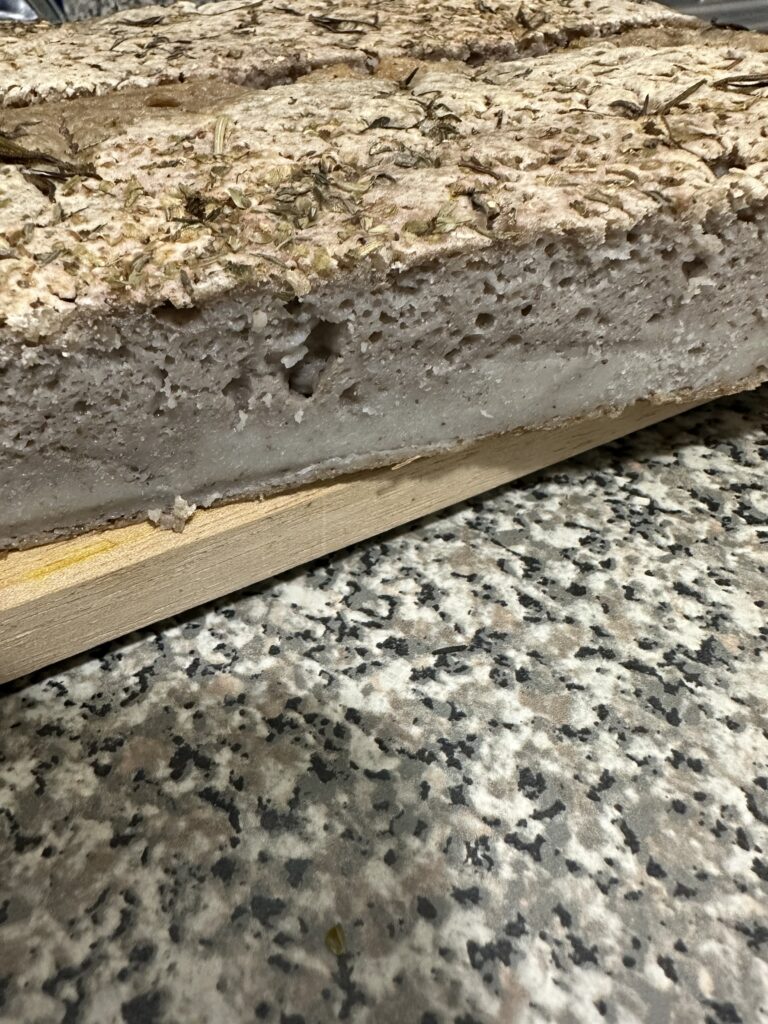
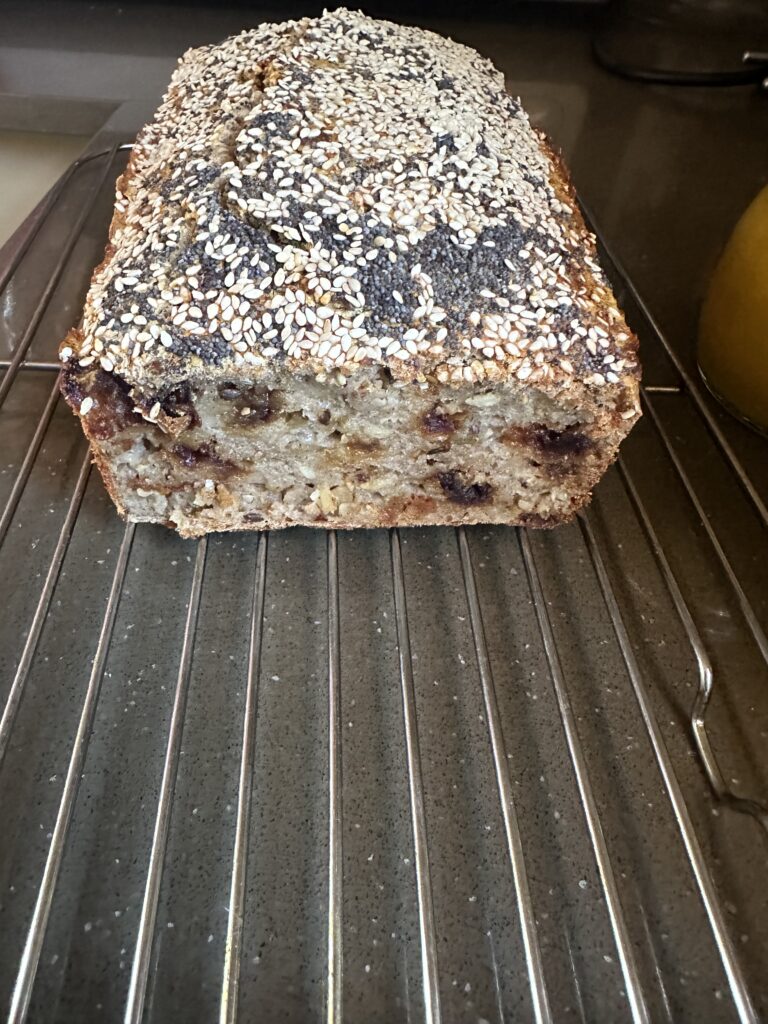








To adjust for baking at my 6000′ elevation, I needed to add “10 min per 30 min of baking time,” so it’s a full 2 hours of baking time, plus raised the temp 25 degrees. It came out crunchy on the outside (like artisan bread, which I like) but the inside was still too moist, and though I like every healthy grain and seed, and sometimes use buckwheat flour in pancakes/waffles, I found I don’t like the taste of 100% buckwheat. I do think the idea is smart, and wonder if it would work with a different grain/seed. I’ll have to give it some thought. I use ancient wheat grains (not commercial wheat, which was modified adversely in the 1970s). I also like sorghum.
Hi Marilyn, thank you for sharing your tips. I have tried it unsuccessfully with barley, let us know if you experiment with other grains, it’s so interesting ❤️
I’m making my second batch today, I love it! It’s easy, nourishing and very satisfying and enjoyable to eat. Thankyou for your recipe 🙏🌻
I’m so happy you’re loving the bread, thank you for sharing Amanda 💚
Can this be done in the air fryer? if yes, Do you know temperature and time?
I have not tried, this bread is cooked a long time on low heat, I’m not sure if you would get a good result in an airfryer. Let us know if you give it a go 💚
Hy Sara! Have you tried baking them in muffin tins? I’m just wondering if it’s possible to make them with a shorter baking time and make them smaller.
I personally have not, but if you go through the blog comment section, you will find a few people have done it, and are sharing their tips 🙂 Let us know how you go x
This bread . . . . thank you. I haven’t been able to experience the “chew” of bread for MANY years. I love how simple it is. I am so appreciative.
I’m so happy it’s helpful 💚 Thank you for sharing Rafia 🙂
The mixture is very liquid. I put 500 grams of the soaked (7hours) and drained buckwheat groats into the blender and added 200 ml of water and a 1/4 teaspoon of salt to ferment for another 12-24 hours. But it’s so liquidy. Any suggestions?
Hi Dana, if you’ve used raw unhulled buckwheat it should be fine! If you watch the video, you’ll notice it’s quite a liquidy dough 🙂 How did you go?
Why did mine slump?
Sorry to hear that, John. If it slumped in the middle, it was likely over-fermented. Shortening your fermentation time slightly should help 🙂
Hi Sarah, I made this bread and it turned out perfect and so delicious. Thank you for sharing!! I will definitely make it again. 😍
I’m very happy to hear that, thank you for sharing Zelda 💚
I’ve made this bread twice and it will be a core base I use.
Question: I live in Australia’s tropics and like the first go, left the second mixture for 24 hours. This effort came out with a pinkish coating on the surface. Was a stronger smell, but not bad. I had placed it in the microwave with the door shut to ferment – away from any potential insects. Is it best to leave covered with a tea-towel in an open space during the day, and in the fridge for part of the time? Thanks!
Hey Leonore, I’m so happy you’re enjoying the recipe! That little pink tint is totally normal with buckwheat, it just means some natural pigments have developed during fermentation. As long as the smell isn’t unpleasant or off (like rotten or sulfur-like), you’re good to go!
Because it’s getting warmer now in Australia, you can start shortening the fermentation time a bit. I’m in Sydney and only let mine go for about 20 hours this week, and it worked perfectly.
The towel is just to keep things from going into it, and won’t impact the fermentation 🙂 Hope this helps 💚
Thanks for getting back to me so quickly. Sorry, but couldn’t “reply” where it said in regards to your information.
Q: What do you think about storing the second ferment covered with a cloth in a microwave with the door closed? Does it need fresh air floating above it, or okay in such a small enclosed space? (Tropics)
Hi Lenore, if it’s very hot and tropical where you are, keeping it on the kitchen counter with a cloth might be best, as the temperature might get higher in the microwave. We’ve had people from hot and humid places such as Kuala Lumpur reporting good results this way by letting it ferment for as little as 6 hours. There’s a bit of trial needed to adjust it to your location, but I promise it’s well worth the effort 💚 Hope this helps x
My indoor temperature is about 18 degrees. But will get cooler overnight (UK). Can I put it in my airing cupboard where it’s warmer. But still leave for 24 hours ? Is there any other test to show it’s properly fermented. Apart from looking ?
What size loaf tin is best. I have 2 1lb ones. So can I divide the mixture and adjust cooking times ? Thank you
Hi Natalie, I’ve never had an airing cupboard myself, so I had to google it, and I’m not exactly sure what that would translate to in terms of temperature. If it’s warmer than 20 °C, a safe approach is to use a glass bowl and check it at around the 20-hour mark. If it already smells fermented and you can see bubbles, then it’s ready to bake. If not, just let it go for another 4 hours.
The loaf pan we use is 9 x 5 in, so if yours are smaller you’ll just need to reduce the cooking time a little. I haven’t tried it myself, but if you look through the comments, some people have even baked them in muffin trays and shared their adjusted times
Hope you love the bread, let us know how you go 💚
Hi Natalie
Yes, I do this! I’m in the UK too and at this time of year the indoor temp is around 18 degrees and lower overnight. I leave my bowl in the kitchen for 18 hours and finish it off in the airing cupboard for the final 6 hours of fermenting when the boiler goes on in the morning.
Hope this helps
Hi, I have made this bread several times. The first time it came out perfect like the first picture you show. The second two times the crust has separated away from the body of the loaf and I don’t understand why that happens or how that happens. Any idea on how to solve this inconsistency? Thanks.
Hi Gerard, I’m so happy you’re enjoying the bread! What might be happening is that the bread is slightly over-fermented. In summer months, you can usually reduce the fermentation time a little. If you’ve been fermenting it for the same amount of time across different seasons, that could explain it. It’s a bit hard to say without seeing your exact process, though. If you have a photo, please feel free to send it to me at sarah@plantbaes.com
(unfortunately we can’t attach photos here). I’d love to see if I can help troubleshoot this with you.
I wanted to love this bread, but I don’t. Although I’ve almost finished the whole loaf with butter and blackberry jelly. It cost over $6 for an organic loaf and my blender wasn’t especially happy. I found that I like it best after freezing and toasting. I think the texture is good if you like a robust, heavier bread with a hearty crust. It was a little wet, but maybe I should have baked it a little longer and it seemed to hold together well. BUT, it has almost no bread taste. I don’t want to add herbs, I’m just wondering if you’ve discovered a way to develop more taste? Thanks so much for your help!
Thank you so much for sharing your honest feedback 💚 Fermented buckwheat bread definitely has a very different flavor compared to wheat bread made with yeast or sourdough, so it can take a little getting used to. The fermentation is what gives it structure, but it won’t develop the same “bread” taste you might be looking for.
If you’re after something gluten-free that’s a bit closer in taste to regular bread, you might enjoy this recipe instead: Gluten-Free Seeded Bread
. It has a lighter flavor profile and could be a better match for you.
I’m really glad you still found a way to enjoy the buckwheat loaf with butter and jelly, and thank you again for giving it a try!
The bread turned out great! I’d love to try it with some of the extras you mentioned. Do you have any suggestions, and what ratio of olives/rosemary/walnuts do you recommend? Thank you again!
Hi Mike, so happy to hear that! I usually use about 1/4 cup of walnuts and 10 chopped kalamata olives, folding them in after fermentation. Then, pour the mixture into your loaf pan and let it sit for an additional 30 minutes to 1 hour before baking for the best results.
I made a fabulous loaf of bread from your recipe in the process of making the second it will be a regular occurrence thank you.
That makes me so happy, thank you for sharing Lynne 🙂
My dough became slight pink on top after 12 hours with temperature of 22 degrees. It may have been a bit warmer as it was near my stove. Does this mean it’s gone bad am I shouldn’t use it?
That’s ok, it does happen sometimes with raw buckwheat due to its natural pigments. As long as it does not developed an unpleasant smell, you are good to go 🙂